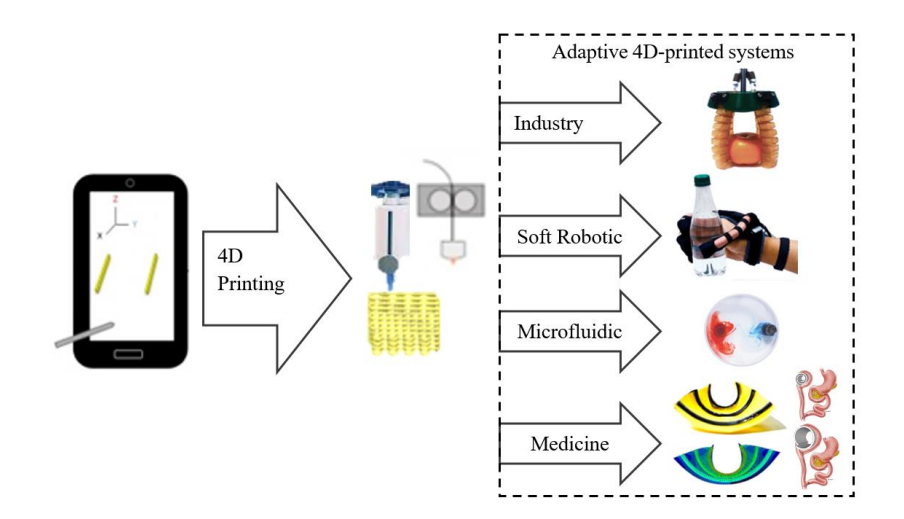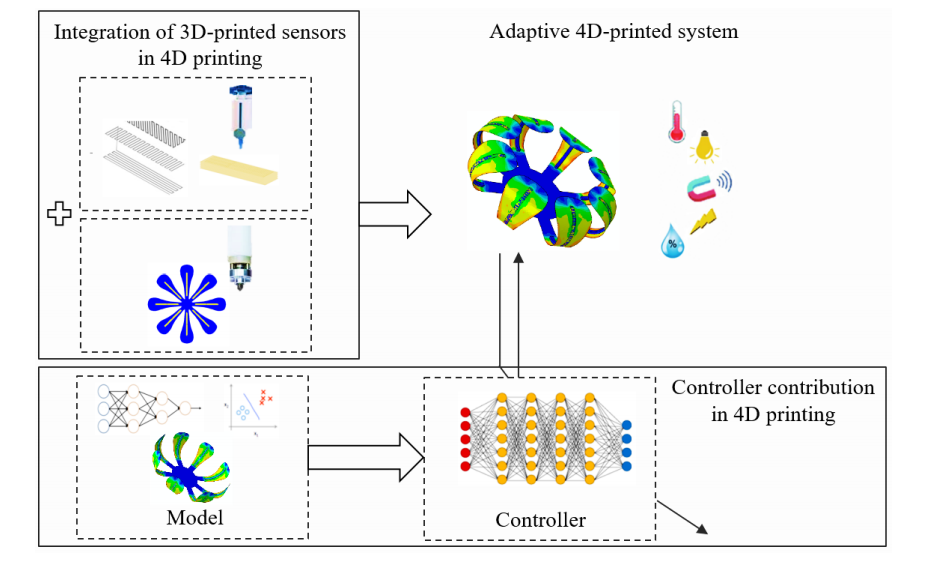Researchers from Australia and the UK are venturing beyond the already complex level of 3D design, releasing the findings of their recent study in ‘Control-Based 4D Printing: Adaptive 4D-Printed Systems.’ As 3D printing has only gained momentum, cementing itself in the mainstream today, technological features have continued to advance, ascending into the 4D and in some cases even 5D.
Studies have been performed regarding 3D, 4D, and 5D printing in applications like medicine, great attention has been paid to the impact on industry in the future, and it is obvious to see why researchers would be fascinated with delving further into the ability to work with shape memory polymers. Just as 3D printing has evolved into a multi-faceted technology, 4D printing is well on its way there too. In this recent study, the researchers worked to understand more about the next dimension in digital fabrication:
“The fourth dimension refers to the dynamic response of the 3D-printed structure in response to a controlled stimuli such as ohmic parameters (current and voltage), water (absorption), heat (pre-strain), electromagnetic radiations (infrared), magnetic field and pH. The 4D printing can biomimic natural processes in self-constructing structures in automotive and aerospace industries, drug delivery and medical devices, soft robotics and other engineering applications,” stated the authors.

Some applications of the adaptive four-dimensional (4D)-printed systems. The images from top right to bottom are reproduced from [29] with the permission of the MDPI, [30] with the permission of the RMIT University Research Repository; Reproduced with permission from [31], Copyright Elsevier, 2015; [32] with the permission of the MDPI.
The goal of the research overall was to develop a concept for adaptive 4D printed systems, presented as robots, smart electronics, and microfluidic devices. Control-based printing is at the foundation of these new developments, with the inclusion of 3D printed layers consisting of sensors, actuators, and a controller.
Sensors can be relied on to measure stress, strain, deformation, acceleration, temperature, humidity, chemicals, and more.
The researchers mention numerous systems that could be developed, from drug release to band-gapping to energy release. Soft robotics is also an area of enormous potential, especially in regard to the use of tools for gripping and handling of more delicate objects. With the combination of sensors and actuators, autonomous and ‘mass-customized systems’ can be created, relying on innovative control algorithms and programming.
Although there are materials available to achieve adaptive 4D-printed systems, there is a scope for further investigations on 3D-printable mechanochromic materials that exhibit variable mechano-responsive properties in different environmental conditions. Moreover, promoting the further applications of adaptive 4D-printed systems in key industries, such as automotive, agriculture and aerospace, demands stimuli-responsive and printable materials with a high thermal and chemical stability to function in corrosive, high-temperature and high-pressure, harsh environmental conditions,” stated the researchers.
In terms of conductivity, other materials that are piezoresistive and piezoelectric may be suitable as well—especially with accompanying sensors and actuators, although further study will be required as printability and performance must be assessed.
While the authors point out that many 4D printed systems today do not offer environmentally friendly methods, their energy consumption is lower than others—and there is the capability for using more natural and biodegradable materials in the future—from chitin to cellulose. Greater recyclability should become more possible, along with the ability to produce a smaller carbon footprint.
“The necessity of adaptive 4D printed systems and their versatile applications require further improvements of 3D printable stimuli-responsive materials in terms of sensitivity, strength and stability, as well as more a precise FEM, and faster voxelized controllers based on the morphological properties,” concluded the researchers. “Developing such systems will open possibilities for innovative applications in medical, manufacturing and agricultural fields.”
What do you think of this news? Let us know your thoughts; join the discussion of this and other 3D printing topics at 3DPrintBoard.com.
[Source / Images: ‘Control-Based 4D Printing: Adaptive 4D-Printed Systems’]Subscribe to Our Email Newsletter
Stay up-to-date on all the latest news from the 3D printing industry and receive information and offers from third party vendors.
You May Also Like
3D Printing News Briefs, April 13, 2024: Robotics, Orthotics, & Hypersonics
In 3D Printing News Briefs today, we’re focusing first on robotics, as Carnegie Mellon University’s new Robotics Innovation Center will house several community outreach programs, and Ugogo3D is now working...
Rail Giant Alstom Saves $15M with 3D Printing Automation Software 3D Spark
3D Spark has entered into a three-year deal with the rail giant Alstom. Alstom, a transport behemoth with annual revenues of $16 billion, specializes in the manufacture of trains, trams,...
Meltio Expands Global Reach with New Partnerships in the Americas and Europe
Spanish 3D printing manufacturer Meltio has expanded its sales network across the globe. With the addition of three new partners in the United States, Brazil, Argentina, and Italy, Meltio aims...
3D Printing Webinar and Event Roundup: April 7, 2024
Webinars and events in the 3D printing industry are picking back up this week! Sea-Air-Space is coming to Maryland, and SAE International is sponsoring a 3D Systems webinar about 3D...

































